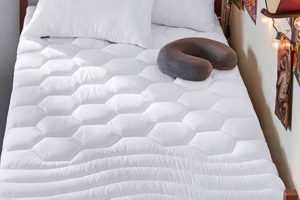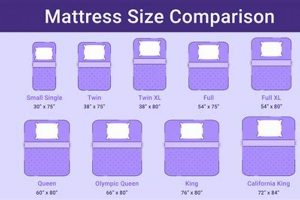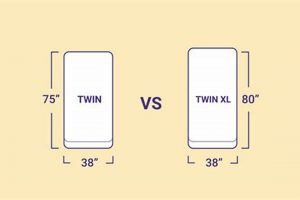The disparity between a standard twin and a twin XL mattress primarily concerns length. A standard twin mattress typically measures approximately 39 inches wide and 75 inches long, whereas a twin XL mattress maintains the same width but extends to around 80 inches in length. This added length provides a more accommodating sleep surface, particularly for taller individuals.
The increased length of a twin XL mattress offers a crucial advantage for those who might otherwise find a standard twin bed too short. This is particularly relevant in college dormitories, where twin XL mattresses are frequently standard issue due to the age and height of the students. Historically, the twin mattress became a common choice for children and smaller adults due to its space-saving size, while the extended length of the twin XL addressed the needs of a growing population seeking comfort without requiring a larger bed frame.
Understanding this dimensional distinction is essential when selecting appropriate bedding, considering room layout, and evaluating individual sleep needs. Factors such as height, sleeping habits, and the intended use of the mattress should be carefully considered to determine which size best suits the user.
Selecting Between Twin and Twin XL Mattresses
Choosing the appropriate mattress size is a critical decision impacting sleep quality and overall comfort. Carefully evaluate individual needs and circumstances before making a selection.
Tip 1: Assess Sleeper Height. A taller individual will generally benefit from the additional length of a Twin XL mattress to avoid discomfort from feet hanging off the edge. Measure the intended sleeper’s height and consider a Twin XL if they are over 5’8″.
Tip 2: Evaluate Room Dimensions. Consider the available space in the bedroom. While a Twin XL offers more length, ensure it doesn’t compromise room functionality or create a cramped environment.
Tip 3: Consider Bedding Availability. Twin-sized bedding is more widely available and often less expensive than Twin XL. Factor this into the decision if budget is a significant concern.
Tip 4: Anticipate Future Needs. If the mattress is for a growing child or teenager, a Twin XL may be a more practical long-term investment as it accommodates their increasing height.
Tip 5: Determine Intended Use. Twin mattresses are commonly used in bunk beds or smaller bedrooms, while Twin XL is often the standard in college dormitories. Consider the mattress’s specific purpose.
Tip 6: Explore Comfort Preferences. Although size is the primary difference, consider trying out both sizes if possible. Individual comfort is paramount, and a slight difference in length can affect sleep quality.
Making an informed decision requires careful evaluation of height, room size, bedding availability, long-term needs, and intended use. The ultimate goal is to select a mattress that promotes comfortable and restful sleep.
With the above considerations addressed, an individual can proceed with confidence towards choosing the optimal mattress size.
1. Length dimension
The length dimension is the principal and defining characteristic differentiating a standard twin mattress from a twin XL mattress. This difference directly impacts suitability for various users and applications.
- Standard Twin Length
A standard twin mattress typically measures 75 inches in length. This dimension proves adequate for children, smaller teenagers, and some adults of shorter stature. However, for individuals exceeding this height, foot overhang becomes a common issue, disrupting sleep quality and comfort. The 75-inch length also limits the potential for full body extension and relaxation during sleep.
- Twin XL Length
A twin XL mattress extends to 80 inches in length, providing an additional five inches compared to a standard twin. This seemingly small difference offers a notable improvement in comfort for taller individuals, preventing foot overhang and promoting a more restful sleep. The added length also caters to the common height of college students, making it a prevalent choice for dormitories.
- Impact on Sleep Quality
Insufficient mattress length compromises sleep quality by forcing individuals to adjust their sleeping positions to avoid discomfort. This can lead to restlessness, frequent awakenings, and ultimately, a less restorative sleep cycle. Conversely, adequate length allows for full body extension, promoting spinal alignment and minimizing pressure points.
- Application-Specific Relevance
The length dimension’s importance varies depending on the application. For bunk beds in children’s rooms, the standard twin’s length is generally sufficient. However, in college dorms or guest rooms intended for a diverse range of users, the twin XL’s added length offers greater versatility and caters to a wider range of heights, reducing the likelihood of discomfort.
In summation, the length dimension is not merely a numerical specification but a critical factor influencing sleep comfort and overall suitability. The five-inch difference between twin and twin XL directly addresses the needs of taller individuals, influencing bed selection across various settings, from residential bedrooms to institutional housing.
2. Dormitory standard
The adoption of the twin XL mattress as a dormitory standard is directly linked to its dimensional advantages over the standard twin, addressing the needs of a specific demographic within the context of shared living spaces. This standard significantly impacts purchasing decisions for both institutions and students.
- Accommodating Taller Students
College and university populations typically include a significant proportion of young adults who exceed the height comfortably accommodated by a standard twin mattress. The twin XL’s additional five inches of length mitigates the issue of feet extending beyond the mattress edge, promoting better sleep posture and reducing discomfort. This directly addresses a prevalent need within the dormitory setting.
- Space Efficiency Considerations
Dormitories often prioritize space efficiency to maximize occupancy within limited square footage. The twin XL maintains the same width as a standard twin, allowing institutions to accommodate taller students without substantially altering room layouts or reducing the number of beds per room. This balance between comfort and spatial constraints is crucial for dormitory planning.
- Standardization for Purchasing and Logistics
Adopting the twin XL as a standard simplifies the purchasing and logistics processes for institutions. Bulk orders of a single mattress size streamline procurement, inventory management, and replacement procedures. This standardization reduces complexity and associated costs for dormitory administrators.
- Impact on Bedding and Accessories
The widespread use of twin XL mattresses in dormitories has influenced the market for bedding and accessories. Manufacturers now produce a wider range of sheets, comforters, and mattress pads specifically tailored to twin XL dimensions, ensuring readily available and affordable options for students and their families. This supply-side adaptation reinforces the twin XL’s position as the dominant dormitory mattress size.
In summation, the twin XL’s status as a dormitory standard is a direct consequence of its ability to meet the combined needs of taller individuals, space-conscious institutions, and streamlined logistical processes. This convergence of factors reinforces the importance of dimensional considerations in mattress selection, particularly within the context of shared residential environments.
3. Taller sleepers
The selection of an appropriate mattress size is intrinsically linked to the physical stature of the sleeper. Height plays a significant role in determining whether a standard twin or twin XL mattress offers adequate comfort and support, highlighting the practical implications of dimensional differences.
- Optimal Spinal Alignment
Taller individuals require a longer sleep surface to maintain proper spinal alignment throughout the night. A standard twin mattress, measuring 75 inches, may not fully support the length of the spine, potentially leading to discomfort, pressure points, and compromised sleep quality. The additional length of a twin XL mattress (80 inches) helps ensure the entire body is supported, promoting healthy spinal posture.
- Prevention of Foot Overhang
A common issue for taller sleepers on a too-short mattress is the uncomfortable and disruptive experience of feet hanging off the edge. This can restrict blood circulation, strain ankle joints, and disrupt sleep. The twin XL provides sufficient length to accommodate the full extension of the legs, eliminating this issue and fostering a more restful sleep environment.
- Enhanced Sleep Comfort
Sufficient mattress length allows for greater freedom of movement and the ability to assume various sleeping positions without constraint. Taller individuals often find themselves restricted on a standard twin, limiting their ability to find a comfortable position. The twin XL offers increased space, enabling a wider range of sleep postures and contributing to overall comfort.
- Long-Term Health Considerations
Consistent use of a mattress that is too short can lead to chronic musculoskeletal issues. Habitually sleeping in a contorted position to fit a smaller mattress can strain muscles, joints, and the spine. Choosing the appropriate mattress length, such as a twin XL for taller individuals, is a proactive step in promoting long-term musculoskeletal health and preventing potential discomfort.
Therefore, the relationship between the height of the sleeper and the dimensional specifications of a mattress is not merely a matter of preference but a fundamental factor affecting sleep quality, comfort, and long-term health. Recognizing this relationship is crucial for making informed decisions regarding mattress selection, ensuring that individuals, particularly taller ones, can enjoy restorative and supportive sleep.
4. Bedding options
The availability and variety of bedding options are directly influenced by mattress size, creating a tangible consequence of the dimensional distinction between standard twin and twin XL mattresses. This affects cost, aesthetic choices, and convenience for consumers.
- Availability and Selection
Standard twin bedding is generally more widely available than twin XL bedding. This increased availability translates to a broader selection of styles, materials, and price points. Consumers seeking standard twin bedding typically encounter a larger range of options compared to those seeking twin XL bedding, particularly in brick-and-mortar retail environments.
- Price Considerations
Due to higher production volumes and broader market competition, standard twin bedding tends to be more affordable than twin XL bedding. Consumers on a budget may find that purchasing bedding for a standard twin mattress is more economical. The price difference can be particularly noticeable when purchasing complete bedding sets, including sheets, comforters, and pillowcases.
- Specialty Retailers and Online Marketplaces
While standard twin bedding is readily available in most retail outlets, twin XL bedding is often more prevalent in specialty retailers or online marketplaces. Consumers may need to seek out specific stores or online vendors to find the desired selection of twin XL bedding. This can require additional research and potentially longer lead times for purchasing.
- Customization and Design
The limited availability of twin XL bedding may restrict customization options. Consumers seeking specific designs, fabrics, or personalized features may find it more challenging to source twin XL bedding that meets their requirements. This can lead to a greater reliance on custom-made bedding, which typically incurs higher costs.
In conclusion, the differing availability, price points, and customization options for bedding represent a practical outcome of the dimensional disparity between twin and twin XL mattresses. This highlights the importance of considering bedding implications when selecting a mattress size, particularly for individuals with specific budgetary or aesthetic preferences. The market reflects the dominance of the standard twin, though the twin XL has a consistent dedicated market especially in the tertiary/dormitory setting.
5. Frame compatibility
Frame compatibility is a critical consideration arising directly from the dimensional differences between twin and twin XL mattresses. The slight variation in length necessitates careful attention to frame selection to ensure proper mattress support and prevent potential damage.
- Dedicated Frame Dimensions
Twin and twin XL mattresses require frames specifically designed to accommodate their respective dimensions. Attempting to use a standard twin frame with a twin XL mattress, or vice versa, will result in an improper fit. This can lead to inadequate support, mattress sagging, and premature wear.
- Structural Integrity and Support
A properly sized frame provides essential structural support for the mattress, distributing weight evenly and preventing deformation. An incompatible frame fails to offer this support, potentially compromising the mattress’s comfort and longevity. The absence of proper support can also void manufacturer warranties.
- Bed Frame Types and Adaptability
Various bed frame types, such as platform beds, slat beds, and adjustable beds, are available in both twin and twin XL sizes. However, not all frames are convertible or adaptable. Consumers must verify the frame’s compatibility with the intended mattress size before purchase, paying particular attention to specified dimensions and weight capacity.
- Box Springs and Foundation Requirements
While some bed frames are designed for direct mattress placement, others require a box spring or foundation for adequate support. The dimensions of the box spring or foundation must also match the mattress size. Using an improperly sized box spring can create an uneven sleep surface and negate the benefits of the mattress.
In conclusion, the dimensional difference between twin and twin XL mattresses necessitates strict adherence to frame compatibility guidelines. Failure to select a properly sized frame can compromise mattress support, reduce lifespan, and potentially void warranties. Careful attention to frame dimensions is therefore essential for ensuring optimal sleep quality and maximizing the investment in a new mattress.
6. Space constraints
Space constraints represent a pivotal factor in determining the suitability of either a standard twin or a twin XL mattress within a given environment. The dimensions of a room, particularly its length and width, directly influence whether the additional five inches of a twin XL are manageable and practical.
- Room Dimensions and Maneuverability
Smaller bedrooms or shared living spaces often necessitate careful consideration of furniture placement to maximize functionality. The added length of a twin XL mattress, while beneficial for taller individuals, can impede movement within the room, restricting access to other furniture or creating a cramped and uncomfortable environment. Evaluating the room’s dimensions and intended layout is crucial before opting for a twin XL.
- Multi-Purpose Room Utilization
In environments where the bedroom also serves as a study area, workspace, or guest room, space constraints become even more critical. The increased footprint of a twin XL mattress can limit the available area for desks, seating, or storage, potentially compromising the room’s versatility. Selecting a standard twin may be preferable in such scenarios to preserve functional space.
- Impact on Visual Perception of Space
Even if the physical dimensions of a room technically accommodate a twin XL mattress, the larger bed can create a visual perception of diminished space. This can lead to a feeling of claustrophobia or confinement, negatively impacting the overall comfort and appeal of the room. A standard twin mattress, by occupying less floor space, may contribute to a more open and airy ambiance.
- Furniture Arrangement and Traffic Flow
Space constraints directly impact the arrangement of furniture within a room and the ease of movement between different areas. The additional length of a twin XL mattress can obstruct pathways, impede access to closets or windows, and necessitate a less-than-ideal furniture configuration. A standard twin may offer greater flexibility in furniture placement, optimizing traffic flow and enhancing the room’s usability.
Consequently, the decision between a twin and twin XL mattress hinges not only on the sleeper’s height and comfort preferences but also on the practical limitations imposed by space constraints. Careful measurement, layout planning, and consideration of the room’s intended function are essential to ensure that the selected mattress size promotes both comfortable sleep and optimal utilization of available space.
Frequently Asked Questions
This section addresses common inquiries regarding the dimensional differences between twin and twin XL mattresses, offering clarity on their respective suitability and applications.
Question 1: Is a twin XL mattress simply a longer version of a twin mattress?
Yes, the primary difference lies in length. A twin mattress typically measures 75 inches long, whereas a twin XL extends to 80 inches. The width remains consistent at approximately 39 inches for both sizes.
Question 2: Can standard twin sheets be used on a twin XL mattress?
No, standard twin sheets are generally too short to adequately fit a twin XL mattress. Twin XL mattresses require sheets specifically designed for their 80-inch length.
Question 3: Is a twin XL mattress suitable for adults?
A twin XL mattress can be suitable for adults, particularly those who are taller than average or who prefer a single-sleeper arrangement. However, it may not provide sufficient width for individuals who prefer ample space or who share the bed with a partner.
Question 4: Are twin XL mattresses more expensive than standard twin mattresses?
Generally, twin XL mattresses tend to be slightly more expensive than standard twin mattresses due to the additional material required for their construction and potentially lower production volumes.
Question 5: Is a specialized bed frame required for a twin XL mattress?
Yes, a twin XL mattress necessitates a bed frame designed specifically for its dimensions. Standard twin frames will not provide adequate support for the longer twin XL mattress, potentially leading to sagging and premature wear.
Question 6: Where are twin XL mattresses commonly used?
Twin XL mattresses are frequently found in college dormitories and guest rooms, where they offer a practical solution for accommodating taller individuals while optimizing space utilization.
In summary, the core difference between a twin and twin XL mattress is length, impacting bedding requirements, suitability for taller individuals, and intended applications.
The following section will explore the practical considerations when making a purchasing decision.
Difference Between Twin and Twin XL Mattress
This exploration of the difference between twin and twin XL mattress sizes has clarified the primary distinction as one of length, with the twin XL offering five additional inches compared to the standard twin. This seemingly small difference has significant ramifications for suitability, particularly concerning taller individuals, space constraints, bedding availability, and frame compatibility. The prevalence of twin XL mattresses in dormitory settings highlights their practicality for a specific demographic, while the wider availability and potentially lower cost of standard twin bedding may appeal to budget-conscious consumers.
Ultimately, the decision to opt for a twin or twin XL mattress requires careful consideration of individual needs and circumstances. Understanding the dimensional differences, as well as their downstream implications, empowers consumers to make informed choices that promote optimal sleep quality, comfort, and long-term value. Selecting the appropriate mattress size is an investment in personal well-being and should be approached with due diligence.






![Best XL Twin Mattress Protector [Guide & Reviews] Organic & Natural Mattress Buyer’s Guide: Non-Toxic Sleep Solutions Best XL Twin Mattress Protector [Guide & Reviews] | Organic & Natural Mattress Buyer’s Guide: Non-Toxic Sleep Solutions](https://mattressworldpa.com/wp-content/uploads/2025/07/th-881-300x200.jpg)
